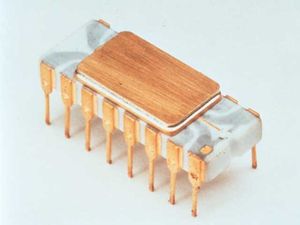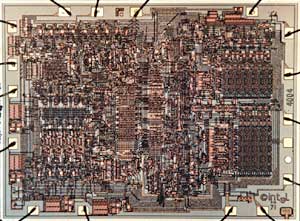Early Microprocessors: Difference between revisions
No edit summary |
No edit summary |
||
| Line 6: | Line 6: | ||
<p>In the late 1960s, lots of engineers knew that circuits could be shrunk down to a size small enough that they could fit entirely on a chip. Gilbert Hyatt of the Micro Computer Company and Gary Boone at Texas Instruments both patented their ideas for single-chip computers. But the most successful version of this idea came from Intel. In the late 1960s, Intel was in the business of making memory chips for computers and calculators. Customers sometimes came to Intel with special projects and requests. One of those requests was for a set of chips for a new calculator that a Japanese company, Busicom, wanted to make in 1969. Intel engineers Marcian “Ted” Hoff, [[Federico Faggin|Federico Faggin]], and [[Stanley Mazor|Stan Mazor]], drew up the plans for a powerful new chip that they would eventually name the microprocessor. The microprocessor could be used in a simple desk calculator or in a much more powerful general-purpose computer. The engineers designed it so that nearly everything the computer needed to work was right there on a single chip. All that would be added was a source of electric power, a keyboard to input data, and a display to show the output. </p> | <p>In the late 1960s, lots of engineers knew that circuits could be shrunk down to a size small enough that they could fit entirely on a chip. Gilbert Hyatt of the Micro Computer Company and Gary Boone at Texas Instruments both patented their ideas for single-chip computers. But the most successful version of this idea came from Intel. In the late 1960s, Intel was in the business of making memory chips for computers and calculators. Customers sometimes came to Intel with special projects and requests. One of those requests was for a set of chips for a new calculator that a Japanese company, Busicom, wanted to make in 1969. Intel engineers Marcian “Ted” Hoff, [[Federico Faggin|Federico Faggin]], and [[Stanley Mazor|Stan Mazor]], drew up the plans for a powerful new chip that they would eventually name the microprocessor. The microprocessor could be used in a simple desk calculator or in a much more powerful general-purpose computer. The engineers designed it so that nearly everything the computer needed to work was right there on a single chip. All that would be added was a source of electric power, a keyboard to input data, and a display to show the output. </p> | ||
<p>[[Image:M3BFL8IQcvsD.jpg|thumb|left|Altair]] </p> | |||
<p>[[Image:Intel4004b.jpeg|thumb|right|Intel 4004 Microprocessor, Source http://forums.techpowerup.com/showthread.php?t=30980%27]]The flexibility built into the Intel microprocessor, called the "4004," was evident to other engineers. A few years later, in 1975 Electronics Magazine published an article on an affordable computer called the Altair that used the new Intel 8080, a second-generation microprocessor. Readers had to build the computer from parts to keep the cost low. This computer kit was sold by a company called MITS. In 1980 IBM decided to use an Intel microprocessor called the 8086 for the first mass-produced personal computer, which was appropriately called the Personal Computer. A new era was underway. As people began to use personal computers for new things, such as word processing and graphic creation, the number of chips inside the box grew larger, but the microprocessor remains the center of attention even today.<br> </p> | <p>[[Image:Intel4004b.jpeg|thumb|right|Intel 4004 Microprocessor, Source http://forums.techpowerup.com/showthread.php?t=30980%27]]The flexibility built into the Intel microprocessor, called the "4004," was evident to other engineers. A few years later, in 1975 Electronics Magazine published an article on an affordable computer called the Altair that used the new Intel 8080, a second-generation microprocessor. Readers had to build the computer from parts to keep the cost low. This computer kit was sold by a company called MITS. In 1980 IBM decided to use an Intel microprocessor called the 8086 for the first mass-produced personal computer, which was appropriately called the Personal Computer. A new era was underway. As people began to use personal computers for new things, such as word processing and graphic creation, the number of chips inside the box grew larger, but the microprocessor remains the center of attention even today.<br> </p> | ||
<p></p> | |||
<p></p> | |||
<p></p> | <p></p> | ||
Revision as of 15:25, 5 November 2010
The Microprocessor: Heart of the Computer
A microprocessor is a type of integrated circuit or chip and is the heart of every computer. Ever since the 1980s, advertisements for personal computers have made a big deal about the microprocessors inside the box, even though every computer relies on dozens of other integrated circuits to work properly. But when it was first invented, engineers thought that the microprocessor would be an entire computer on a chip.
In the late 1960s, lots of engineers knew that circuits could be shrunk down to a size small enough that they could fit entirely on a chip. Gilbert Hyatt of the Micro Computer Company and Gary Boone at Texas Instruments both patented their ideas for single-chip computers. But the most successful version of this idea came from Intel. In the late 1960s, Intel was in the business of making memory chips for computers and calculators. Customers sometimes came to Intel with special projects and requests. One of those requests was for a set of chips for a new calculator that a Japanese company, Busicom, wanted to make in 1969. Intel engineers Marcian “Ted” Hoff, Federico Faggin, and Stan Mazor, drew up the plans for a powerful new chip that they would eventually name the microprocessor. The microprocessor could be used in a simple desk calculator or in a much more powerful general-purpose computer. The engineers designed it so that nearly everything the computer needed to work was right there on a single chip. All that would be added was a source of electric power, a keyboard to input data, and a display to show the output.

The flexibility built into the Intel microprocessor, called the "4004," was evident to other engineers. A few years later, in 1975 Electronics Magazine published an article on an affordable computer called the Altair that used the new Intel 8080, a second-generation microprocessor. Readers had to build the computer from parts to keep the cost low. This computer kit was sold by a company called MITS. In 1980 IBM decided to use an Intel microprocessor called the 8086 for the first mass-produced personal computer, which was appropriately called the Personal Computer. A new era was underway. As people began to use personal computers for new things, such as word processing and graphic creation, the number of chips inside the box grew larger, but the microprocessor remains the center of attention even today.
